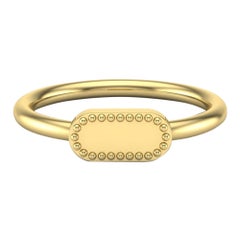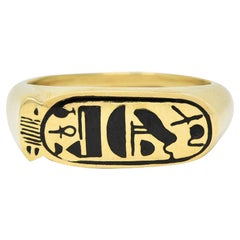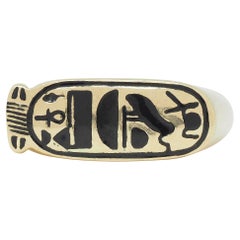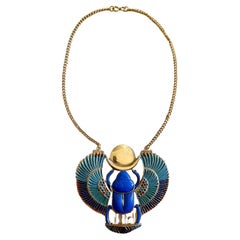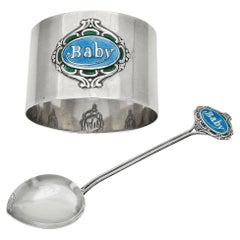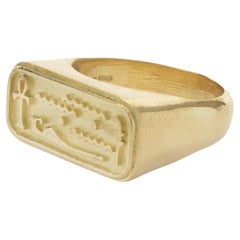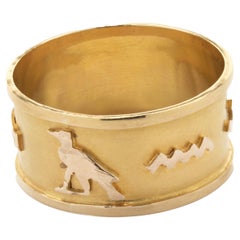Cartouche Ring
Antique 15th Century and Earlier Italian Classical Roman Signet Rings
Gold, 22k Gold, Yellow Gold
Late 20th Century European Egyptian Revival Fashion Rings
Silver, Sterling Silver
21st Century and Contemporary American Contemporary Fashion Rings
Lapis Lazuli
21st Century and Contemporary Egyptian Revival Signet Rings
Gold, 14k Gold, Yellow Gold, Enamel
21st Century and Contemporary Egyptian Revival Signet Rings
Gold, 14k Gold, Yellow Gold, Enamel
Vintage 1970s English Art Nouveau Pendant Necklaces
Enamel
Antique Early 1900s British More Objets d'Art and Vertu
Sterling Silver, Enamel
21st Century and Contemporary Signet Rings
18k Gold, Yellow Gold
21st Century and Contemporary Band Rings
14k Gold, Yellow Gold
Vintage 1940s Unknown Cocktail Rings
Topaz, Diamond, 18k Gold
Vintage 1970s French Modernist Cocktail Rings
White Diamond, Diamond, Platinum, Yellow Gold, 18k Gold, Gold
Vintage 1970s More Rings
Mid-20th Century Cocktail Rings
Gold, 14k Gold
Mid-20th Century Cocktail Rings
Gold, 14k Gold
Late 20th Century American Revival Fashion Rings
Diamond, Onyx, Gold, 18k Gold
Vintage 1910s British Signet Rings
Yellow Gold
2010s American Contemporary Cocktail Rings
Lapis Lazuli, Gold, 18k Gold, Yellow Gold
Mid-20th Century French Art Deco Fashion Rings
Coral, Diamond, Yellow Gold, Platinum
Vintage 1980s French Choker Necklaces
Late 20th Century Italian Fashion Rings
18k Gold
Antique 1880s European Victorian Band Rings
18k Gold, Rose Gold, Enamel
21st Century and Contemporary Swiss Wrist Watches
18k Gold
Vintage 1970s British Modern Signet Rings
Yellow Gold
Antique Late 18th Century British Regency Signet Rings
18k Gold
Cartouche Ring For Sale on 1stDibs
How Much is a Cartouche Ring?
Why Gold Shines in Jewelry Craftsmanship
Gold is the feel-good metal, the serotonin of jewelry. Wear vintage and antique gold necklaces, watches, gold bracelets or gold rings and you feel happy, you feel dressed, you feel, well, yourself.
Gold, especially yellow gold, with its rich patina and ancient pedigree going back thousands of years, is the steady standby, the well-mannered metal of choice. Any discussion of this lustrous metal comes down to a basic truth: Gold is elementary, my dear. Gold jewelry that couples the mystique of the metal with superb design and craftsmanship achieves the status of an enduring classic. Many luxury houses have given us some of our most treasured and lasting examples of gold jewelry over the years.
Since its founding, in 1837, Tiffany & Co. has built its reputation on its company jewelry as well as its coterie of boutique designers, which has included Jean Schlumberger, Donald Claflin, Angela Cummings and Elsa Peretti. There are numerous gold Tiffany classics worth citing. Some are accented with gemstones, but all stand out for their design and the workmanship displayed.
For the woman who prefers a minimalist look, the Tiffany & Co. twist bangle (thin, slightly ovoid) is stylishly simple. For Cummings devotees, signature pieces feature hard stone inlay, such as her pairs of gold ear clips inlaid with black jade (a play on the classic Chanel black and tan), or bangles whose design recalls ocean waves, with undulating lines of lapis lazuli and mother-of-pearl. And just about any design by the great Jean Schlumberger is by definition a classic.
Even had he eschewed stones and diamonds, Southern-born David Webb would be hailed for the vast arsenal of heavy gold jewelry he designed. Gold, usually hammered or textured in some manner, defines great David Webb jewelry. The self-taught jeweler made very au courant pieces while drawing inspiration from ancient and out-of-the-way sources — East meets West in the commanding gold necklaces made by Webb in the early 1970s. The same could be said for his endlessly varied gold cuffs.
In Europe, many houses have given us gold jewelry that sets the highest standard for excellence, pieces that were highly sought after when they were made and continue to be so.
Numerous designs from Cartier are homages to gold. There are the classic Trinity rings, necklaces and bracelets — trifectas of yellow, white and rose gold. As a testament to the power of love, consider the endurance of the Cartier Love bracelet.
Aldo Cipullo, Cartier’s top in-house designer from the late 1960s into the early ’70s, made history in 1969 with the Love bracelet. Cipullo frequently said that the Love bracelet was born of a sleepless night contemplating a love affair gone wrong and his realization that “the only remnants he possessed of the romance were memories.” He distilled the urge to keep a loved one close into a slim 18-karat gold bangle.
BVLGARI and its coin jewelry, gemme nummarie, hit the jackpot when the line launched in the 1960s. The line has been perennially popular. BVLGARI coin jewelry features ancient Greek and Roman coins embedded in striking gold mounts, usually hung on thick link necklaces of varying lengths. In the 1970s, BVLGARI introduced the Tubogas line, most often made in yellow gold. The Tubogas watches are classics, and then there is the Serpenti, the house's outstanding snake-themed watches and bracelets.
A collection called Monete that incorporated the gold coins is one of several iconic BVLGARI lines that debuted in the 1970s and ’80s, catering to a new generation of empowered women. Just as designers like Halston and Yves Saint Laurent were popularizing fuss-free ready-to-wear fashion for women on the go, BVLGARI offered jewels to be lived in.
Since Van Cleef & Arpels opened its Place Vendôme doors in 1906, collection after collection of jewelry classics have enchanted the public. As predominantly expressed in a honeycomb of gold, there is the Ludo watch and accessories, circa the 1920s, and the golden Zip necklace, 1951, whose ingenious transformation of the traditional zipper was originally proposed by the Duchess of Windsor. Van Cleef's Alhambra, with its Moroccan motif, was introduced in 1968 and from the start its popularity pivoted on royalty and celebrity status. It remains one of VCA’s most popular and collected styles.
Mention must be made of Buccellati, whose name is synonymous with gold so finely spun that it suggests tapestry. The house’s many gold bracelets, typically embellished with a few or many diamonds, signified taste and distinction and are always in favor on the secondary market. Other important mid-20th-century houses known for their gold-themed jewelry include Hermès and Ilias Lalaounis.
Find a stunning collection of vintage and antique gold jewelry on 1stDibs.
